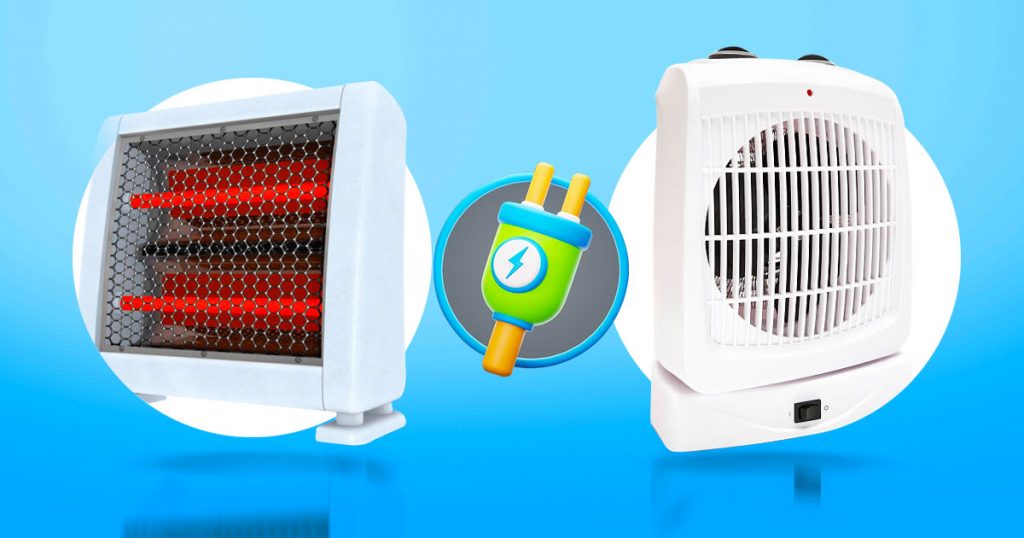Heating is a fundamental component of any home, especially for those residing in regions with harsh winter conditions. An efficient heating system is not just a luxury; it’s a necessity for maintaining a comfortable living environment during the colder months. According to the U.S. Energy Information Administration, nearly 50% of American homes rely on electricity for heating. This statistic underscores the importance of having an effective and efficient heating system. When it comes to portable heating solutions, two of the most prominent types are ceramic heaters and fan heaters.
Understanding Ceramic Heaters and Fan Heaters
Ceramic heaters and fan heaters are both popular choices when it comes to providing supplemental heat in your home. Both are electric heaters, meaning they convert electrical energy into heat, but they do so in slightly different ways.
Ceramic Heaters
These heaters work by passing electricity through ceramic plates. The ceramic plates absorb the heat and transfer it to the surrounding air. A built-in fan then disperses this heated air throughout the room. Ceramic heaters are highly effective at providing targeted heat quickly, making them ideal for small to medium-sized spaces.
Fan Heaters
Also known as convection heaters, fan heaters operate by passing electricity through a heating element, usually made of metal. The heat generated is then blown out by a fan, heating the room. While not as fast at heating up as ceramic heaters, fan heaters are efficient at warming larger spaces.
Advantages of Ceramic Heaters Over Fan Heaters
Faster Heating
Ceramic heaters are known for their ability to heat up almost instantly. They use ceramic plates that absorb and retain heat very effectively, which allows them to start warming the surrounding area much quicker than most other types of heaters.
Energy Efficiency
Ceramic heaters are one of the most energy-efficient types of electric heaters on the market. They consume less electricity compared to fan heaters because they generate heat by passing electricity through ceramic elements, which is a more efficient process than heating metal coils or wires, as in fan heaters.
Safety Features
Modern ceramic heaters often come with a host of safety features. Tip-over protection automatically shuts off the heater if it gets knocked over, preventing potential hazards. Overheating protection is another common feature, where the heater will automatically turn off if it gets too hot, reducing the risk of fire.
Precise Temperature Control
Most ceramic heaters offer adjustable thermostats and multiple heat settings. This allows you to control the temperature of your space with precision, ensuring you stay comfortable without wasting energy.
Quiet Operation
While ceramic heaters do use a fan to distribute heat, the noise produced is often less than that of a typical fan heater. This means you can enjoy a warm room without the intrusion of loud operational noises.
Advantages of Fan Heaters Over Ceramic Heaters
Cost-Effective
Fan heaters are generally cheaper to purchase upfront than ceramic heaters. This makes them an attractive option for those needing a heating solution on a budget.
Heating Larger Spaces
Fan heaters, especially larger models, are capable of heating larger spaces more effectively than ceramic heaters. This is because the fan can spread the warm air further around the room, making them ideal for larger living areas.
Simplicity
Fan heaters usually have a very simple, user-friendly design. They typically have straightforward controls, such as a dial to adjust the temperature, making them easy to operate even for those who aren’t tech-savvy.
Portability
Fan heaters are often compact and lightweight, making them easy to move around. This means you can easily transport them from room to room, or even take them with you if you’re traveling.
Quieter Operation
While fan heaters do generate noise, they can be quieter than ceramic heaters when set on a low setting. This is because they don’t need to continuously use a fan to distribute the heat, allowing for quieter operation when less heat is needed.
Disadvantages of Fan Heaters vs Ceramic Heaters
While ceramic heaters are praised for their advantages, they also have some shortcomings when pitted against fan heaters. The primary downside is their cost; these heaters are generally more expensive due to their intricate heating components and added safety attributes.
Although ceramic heaters are proficient at rapidly warming small to medium-sized rooms, their performance dwindles in larger spaces as the range of the ceramic element is limited. They’re also bulkier and heavier than fan heaters, which detracts from their portability. While they are typically quieter, some users may find the hum or buzz they produce in tranquil settings annoying.
On the flip side, fan heaters, when contrasted with ceramic heaters, also have a list of disadvantages. They tend to use more electricity for the equivalent heat output, potentially resulting in increased energy costs. Fan heaters rely on circulating air for heat distribution, which can be inefficient in drafty or poorly insulated rooms. They are often louder than ceramic heaters, with the noise from the fan possibly causing disturbances.
Additionally, fan heaters often lack the sophisticated safety features found in ceramic heaters, such as protection against tipping over and automatic shut-off if overheating occurs, which could present safety hazards.
Deciding Between Ceramic & Fan Heaters Based on Your Individual Needs
In conclusion, the choice between a ceramic heater and a fan heater largely depends on your individual needs, preferences, and circumstances. While ceramic heaters are great for small to medium-sized rooms and offer added safety features, they may be more expensive and less portable. On the other hand, fan heaters can be more economical and better for larger spaces, but they may consume more electricity and lack advanced safety features.
Therefore, when choosing between a ceramic heater vs a fan heater, it’s important to consider the specific requirements of your space, your budget, and your personal comfort. Remember, the best heater for you is one that effectively and efficiently meets your heating needs.

